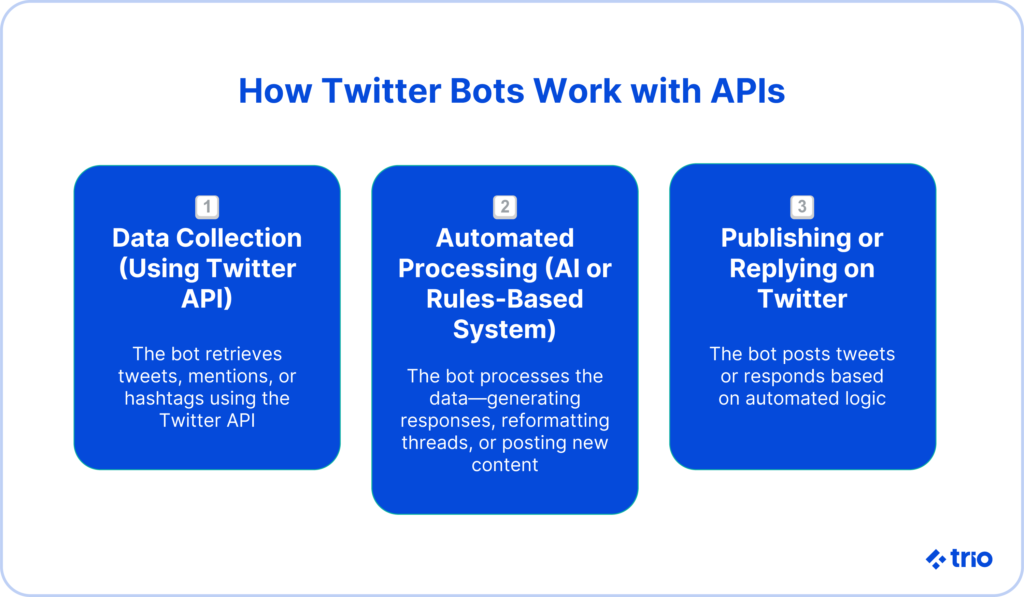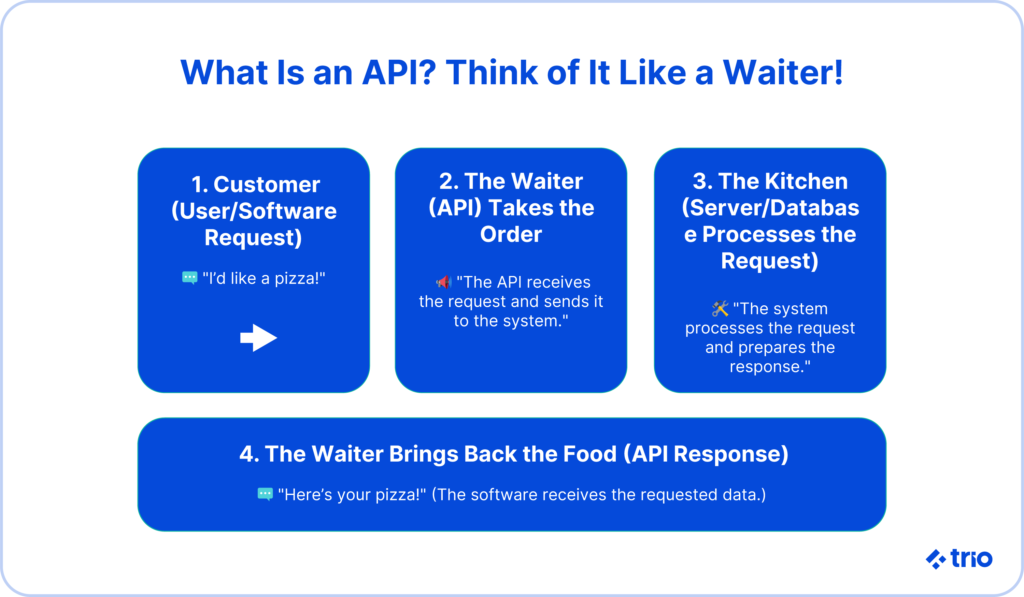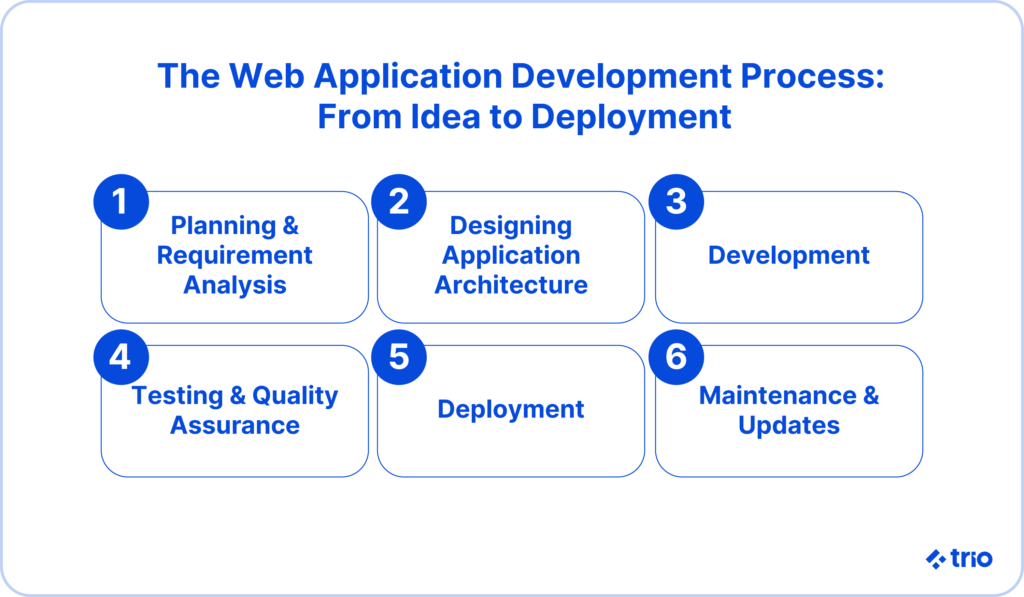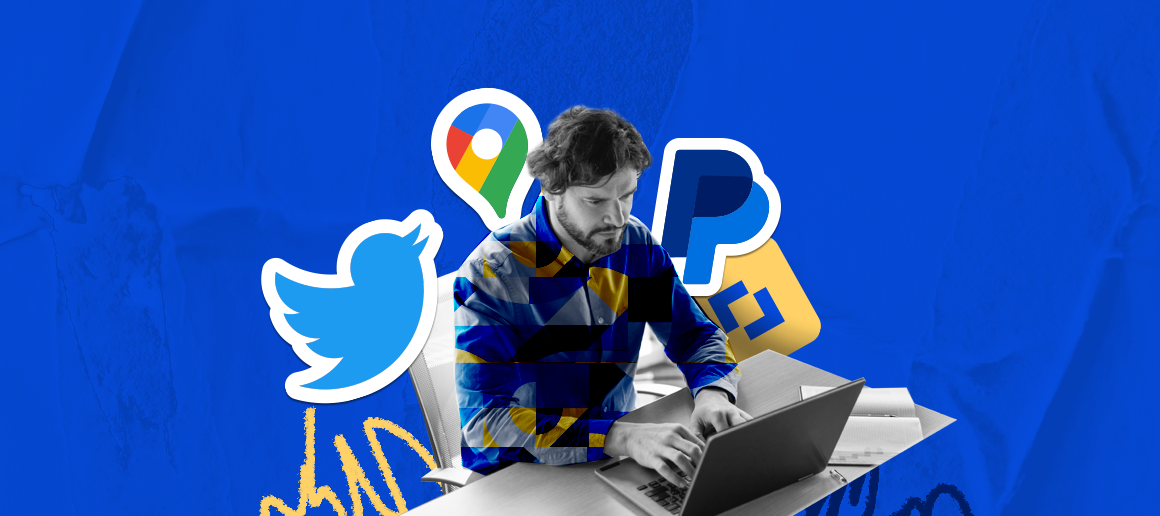API examples are littered throughout your everyday life, whether you know it or not. This is because APIs are the primary software infrastructure ensuring that distinct software can work in unison.
From social media integrations to online shopping and cloud-based applications, APIs enable seamless connectivity between different systems, making modern digital experiences possible.
Before today, you may not have realized how important it is for software to work together or how often it’s really happening behind the scenes. If you are an experienced Back-End developer, you are certainly familiar with the foundational value of APIs. But if you are not, we hope that you can learn a little better through these seven real-world API examples, including:
- Twitter Bots
- Log-In Using XYZ
- Weather Snippers
- Pay with PayPal
- Google Maps
- Travel Booking
- E-Commerce
These API examples will deepen your understanding of the concept and its practical use in the software industry.
But APIs are just one part of a much larger ecosystem—web application development. Web applications rely on APIs to function efficiently, connecting users, databases, and services across the internet. To fully understand APIs, it helps to explore their role within the broader context of web application development.
We’ll not only explore common API examples but also break down the fundamentals of web application development, showing how APIs fit into the process. Keep reading to learn more!
Are you ready to start your development project?
We have the developers you need to take your development project in the right direction.
Companies are proven to grow their business faster with Trio.
@trio.devAPIs and data integrations are your best friends when building a software project #API #software #data #dataintegration #softwareengineer #softwareengineer #tech #techleader #teamaugumentation #developer #dev #company #grow #outsource #outsourcing #nearshore #trio #outsourcegengineers♬ original sound – Trio
7 Examples of APIs
To be fair, it’s a bit difficult to truly understand application programming interfaces without knowing their real-life applications. Below are seven API examples demonstrating various types of APIs.
1. Twitter Bots
If you spend a significant amount of time on Twitter, then you’ve probably come across a bot at one point or another. Twitter has numerous bots that utilize the Twitter API to perform automated tasks.
Over a decade ago, Twitter bots accounted for 24% of tweets. No doubt, today, their involvement is even greater. There are so many bots that it’s hard to find which ones stick out more than the others.
However, for the purpose of giving API examples, it’s worth discussing one or two notable Twitter bots.
One fan favorite is @MagicRealismBot, a Twitter bot that generates magical stories every four hours. It uses a random combination of genre-defining elements and plugs them into a 280-character tweet.

A more utilitarian Twitter bot is called @ThreadReaderApp. Twitter users can tag the bot under any thread. Then, the bot wraps up all the text from the thread and presents it as normal, readable text on a page.
Both these bots take advantage of the Twitter API to work successfully with Twitter’s interior software system.
2. Log-In Using XYZ
Okay, so there’s a fair chance you don’t have an account on any platform called “XYZ”. No worries.
Really, the idea is that to sign up for or log into virtually any online service, you now have the option to avoid managing a separate account with its own data.
To be clear, surely there are a variety of circumstances where you’ve clicked “login using Facebook” or “login using Google”.
The effort of creating a whole new account for a certain platform just didn’t seem worth it. Luckily, there was a workaround readily available.
But you have to remember that whichever platform you are on doesn’t just happen to be best friends with Google, Facebook, Twitter, or any other social account.
Even logging in with your information from other platforms requires an API to connect the two platforms together. This is an API example in its natural habitat.
3. Weather Snippets
Ever do a Google search for the weather? A good search input likely results in a pop-up weather snippet right front and center on your Google search page.
This is a common Google feature that many smartphone users put to use every day, if not several times a day. It’s also a convenience many have taken for granted.
This is because weather snippets are a prime API example, showing how Google coordinates with other software on the web.
4. Pay with PayPal
Another popular API example is PayPal. PayPal is a fintech service that allows users to connect personal financial information to their PayPal account. This paves the way for easier, more secure money transfers.
You’ll see PayPal intentionally embedded into any number of websites that require financial transactions, from eBay to Airbnb.
The websites interacting with PayPal will not have direct access to your bank or card info. Your security in this regard is because of API integrations.
5. Google Maps
The Google Maps API gives users the privilege of nearly limitless geographic aptitude at their fingertips. Search nearby restaurants, niche shops, and whatever else is in relative distance to your location.
Whether you are a Senior Developer with extensive experience in development or just an active user of technologies, you may have been using this API example more often than you realize. Each time you glimpsed business hours, reviews, contact information, or anything of that nature from that handy box on your screen, that is the Google Maps API in action.
To that same effect, clicking on the map icon in that box will open the Google Maps app for you or take you straight to the Google Maps website.
6. Travel Booking
Travel booking is a very useful API example because making connections and building relationships are the exact point of most travel websites.
That is, travel websites like Trivago and Expedia have the power to feature and sell all-inclusive travel packages that account for both lodging and travel.
But it’s not just a coincidence that travel booking platforms can pull flight information from American Airlines and book you nights at the Marriot.
No, this is the honest, hard work of application programming interfaces.
7. E-commerce
E-commerce involves conducting commercial activities like buying and selling products online. PayPal, for one, is a service almost emblematic of e-commerce. Amazon and Facebook both have trademark marketplaces that are representative of e-commerce.
In general, APIs are a big part of e-commerce, providing e-commerce platforms with security, speed, and scalability. Functions of e-commerce platforms like site search and currency conversion require APIs to operate properly.
Microservice architecture is also integral to e-commerce. Many e-commerce platforms use microservices to encapsulate functionality into separate, independently deployable services.
Such a means of application development offers decentralization and business capability that a monolithic architecture simply cannot.
But the most important bit to note here is that microservices — being independently deployable and all — come together in a single application via APIs.

Elevate Your Team with Trio AI Talent
Empower Your Projects with Trio’s Elite Tech Teams
What Is An API?
An application programming interface (API) is the medium by which different software interact. They foster connections between technologies to enhance user experience. APIs act as bridges that allow software applications to communicate with each other, enabling seamless integration and automation across the web.
For someone who is not tech-savvy, think of an API as a waiter for the software world. Strangely enough, a waiter and an API have some parallels when it comes to their function.
To illustrate, a waiter takes orders from customers and brings those orders to the kitchen. After preparation, the waiter then brings the customers their food.
In this way, the waiter serves as a middleman of sorts, facilitating communication between the table they’re waiting on and the kitchen that prepares the food.
Similarly, an API works as a facilitator, connecting software platforms that would otherwise not be able to interact. For example, when you use a travel booking website to compare airline prices, the platform fetches data from different airline APIs to display real-time prices and availability.
In practice, an API simply looks like a hefty block of code. But it empowers developers to build user-friendly software.

What is Web Application Development
Web app development is a relatively complex process where software applications are created to run on web servers.
Think of things like online banking, social networking sites, and anywhere you can make an e-commerce transaction.
How Web Applications Differ From Traditional Websites
They’re a little different from normal websites – like blog pages or news articles – as they don’t have static content. Instead, they are dynamic and interactive, performing tasks. Users can perform actions, input data, and receive personalized responses.
There’s usually a lot of back-end code involved in web apps that power all the structures, while the front-end builds the graphical interface that your users see. These two parts need to communicate with one another quickly and efficiently in order for the application to work well.
This is where APIs come in! APIs act as intermediaries, helping web applications fetch, update, and display data dynamically. They are like a bridge between the front and back ends, allowing the web application to work as it should.
Importance of Web Applications
There are several reasons why you might want to consider a web application over something more static or sometimes even over a mobile app.
They are accessible from any device with an internet connection, so your users don’t need to install separate applications. This also means that you don’t need to create different apps for different operating systems. You don’t need to worry about getting your users to install updates either.
Another major advantage of web applications is their ability to engage users through interactive and personalized experiences rather than having a one-size-fits-all approach for everyone who comes across your app.
Scalability is also a key benefit, as cloud-hosted web applications can accommodate growing numbers of users. And, if you use APIs correctly, not only do these apps work efficiently, but you can integrate them with external services, like social logins, payment gateways, and external databases.
Types of Web Applications
There are five main types of web apps.
- Static Web Applications
- Dynamic Web Applications
- Single Page Applications (SPAs)
- Progressive Web Applications (PWAs)
- E-commerce Applications
Static web apps are the most simple and generally only show pre-rendered content, so every user sees the same thing. Dynamic web applications are closer to the kind we talked about above, which generate content based on what a user does. API’s are very important for this.
Single-page applications are what they sound like. The whole website is found on one page, and instead of reloading entire pages when your users navigate between sections, the content is dynamically updated in sections. Think of something like Gmail or Trello.
PWAs are somewhere between web and mobile apps. They function online but can make use of features like push notifications and can work when users lose internet connections. APIs are critical for helping these apps synch data when users have an internet connection.
E-commerce apps are simple to understand because of how common they are. Everyone has been on Amazon or Shopify. APIs are generally used for managing payment processes, shipping logistics, customer authentication, and a host of other features.
Web Application Development Process
The process of creating your web app can be rather complex. If you are not already familiar with it, we’d recommend that you make use of a company like Trio to ensure that you do not miss any important steps that will affect speed and cost at a later date. Here’s a brief walkthrough of what you can expect, though.
First, you’ll need to focus on planning and requirement analysis. You’ll need to know everything you need ahead of time so you can be prepared from the start. Once you are ready, you can move on to designing application architecture. This is like a skeleton and helps you see how your front end, back, and databases will interact.
Don’t forget to include the APIs in the architecture to make sure that you have smooth communication between internal and third-party services from the start.
Finally, you can move on to the actual development of your application. You’ll probably need a team of developers specializing in front-end development, back-end development, and database management. It is also a good idea to get some quality assurance specialists on board to test the code in various stages.
This will help you minimize the number of issues that may emerge when you conduct the final bouts of testing and quality assurance before deployment.

Once you have deployed your app, don’t think that your development work is finished. You will need to put some effort into continued maintenance so that you can ensure your app continues to work well, third-party features are changed over time, and your user expectations evolve with emerging trends.
Frameworks and Tools for Web App Development
Front-end frameworks like React, Angular, and Vue.js are some of the most popular options for developers to build interactive user interfaces. At Trio, many of our front-end developers are particularly partial to React, especially with React 19 having come out in 2025, but they are familiar with a myriad of options.
Popular options for back-end frameworks include Node.js, Django, and Ruby on Rails, which handle server-side logic. Bun, a newer JavaScript runtime, is also becoming more popular. All of these frameworks have different libraries that allow you to create the web app that you need.
Outside of these two, you will probably need to make use of databases like MySQL, MongoDB, and PostgreSQL to store essential application data, as well as DevOps tools such as Docker, Kubernetes, and Jenkins to streamline deployment and maintenance processes.
Best Practices in Web App Development
There are many different best practices that you should be considering for your web app development. Many of these best practices will change based on the industry that you are in, the regulations of your country or region, and the type of app that you are creating.
However, there are some general things you should consider that are pretty much required for all web apps, regardless of industry or any other specifications.
- Responsive Design: You need your app to work on different screen sizes so users feel there is consistency on desktops, tablets, and mobile devices. With AI-driven design tools like Framer and Figma AI, this is becoming easier.
- Security Measures: Authentication protocols, encryption, and secure APIs can help protect your users from cyber threats.
- Performance Optimization: Applications that are slow or lag can cause users to abandon them, so it’s important to use caching, lazy loading, and any other performance optimization techniques where possible.
- User Experience (UX) Design: Focus on making your website easy and intuitive to navigate, whether that’s through clear hierarchies or consistent designs.
- Accessibility Considerations: There are many accessibility standards that help people with disabilities or impairments use your site. This can include text-to-speech integration and alternate text for images.
Conclusion
Hopefully, these nine API examples engender a better understanding of how crucial APIs are in software development. It should be obvious now that APIs are in most, if not all, technology humans use on a day-to-day basis.
If you have an upcoming software project, there’s little to no question that APIs and data integrations will play a role in development.
Tell us everything you need, and we’ll find the best developers or team for you!







